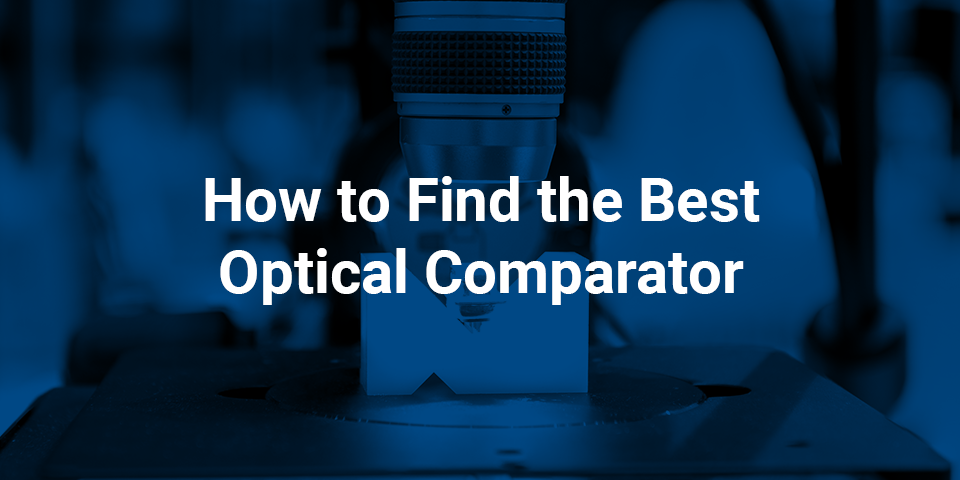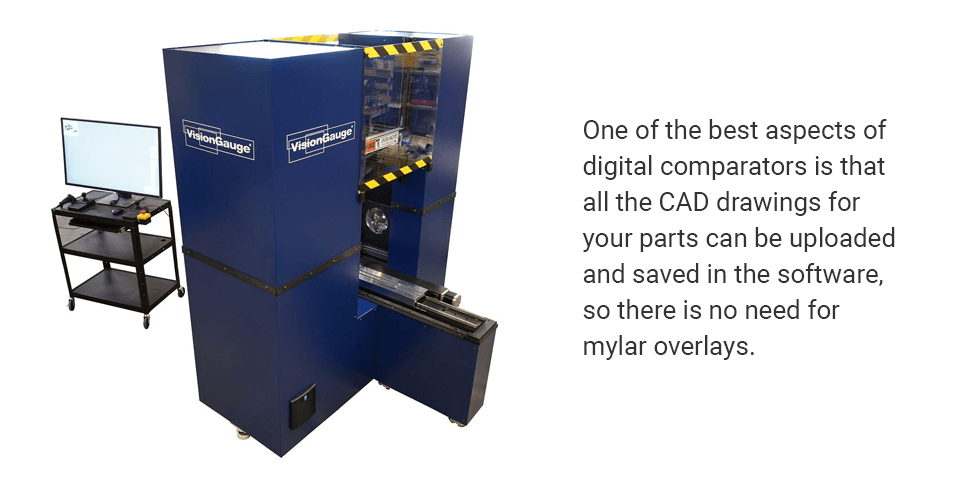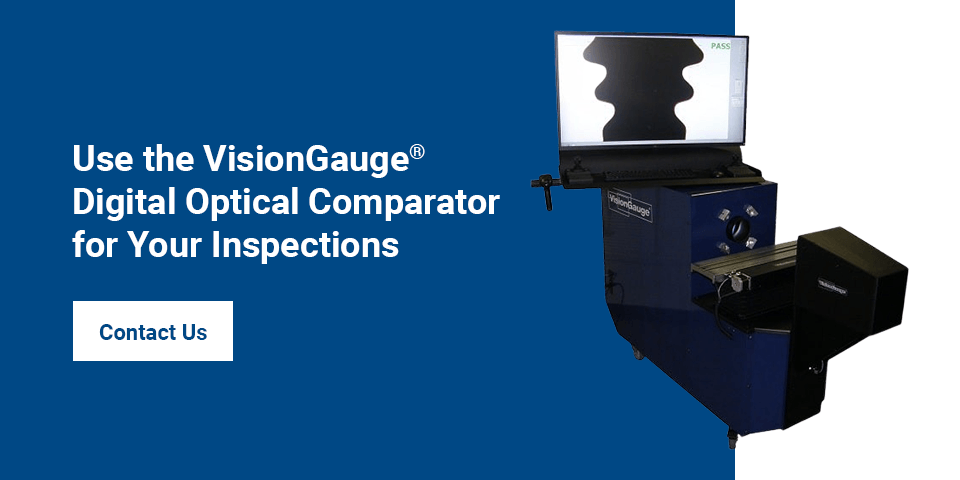
Also known as profile projectors, optical comparators are used in various industries to measure, analyze, and inspect manufactured parts and compare them to their design specifications. This process of comparing the existing part to its prescribed limits helps ensure parts fall within tolerance before use and that they are not overused or damaged. Comparators use lights, mirrors, and lenses to magnify a part and display the image on a screen for viewing.
Table of Contents
- Choosing the Right Type for Your Application
- Traditional vs. Digital
- Accuracy
- Optical Comparator Accessories and Characteristics
- Choosing a Reliable Manufacturer
- Technical Support
- Application Support
- Use the VisionGauge® Digital Optical Comparator for Your Inspections
Comparators can vary in a few ways, and the best type of optical comparator for your application will likely depend on your needs, including the parts themselves and your inspection requirements. Find out how to determine the best optical comparator with this guide.
Choosing the Right Type for Your Application
When choosing an optical comparator, you have some decisions to make regarding features that would best suit your application. Optical comparators can come in two configurations — vertical and horizontal — which is how the light shines on a part. In vertical optical comparators, the light shines vertically on the part so that the operator is looking down on it. In contrast, horizontal comparators provide a silhouette of the side of a part.
Both configurations can be used to inspect parts in various industries, ranging from manufacturing to aerospace. Ultimately, the configuration you choose will depend on the parts you’re inspecting.
Traditional vs. Digital
One of the biggest decisions to make is whether you’ll choose a traditional or digital comparator. Both types have their place in machinery inspection, though one is more efficient than the other.
The traditional optical comparator has had close to the same design since the birth of this technology in the 1920s. Traditional comparators require an operator to line a part up with a mylar overlay that serves as a guide for manual comparison. After aligning the overlay with the part, the operator determines whether the component can still be used if there are discrepancies. Overall, traditional comparators are fairly easy to use, though the manual process is slow and less accurate.
As technology advanced, comparators saw a digital shift. Digital optical comparators make the inspection process significantly more streamlined and precise. Instead of an operator taking measurements manually, parts are automatically compared directly with their CAD drawings to get a precise comparison. The automated process also can inspect multiple pieces at once, making the job much more effective.
Because digital comparators allow operators to inspect multiple parts simultaneously, they’re typically a more efficient option for applications requiring regular inspection of many parts. Both types of comparators have their worth in certain applications, and the best optical comparator for you will depend on your industry’s demands.
Accuracy
As machinery becomes more advanced and parts become more specific, the need for more accurate inspections and comparisons increases. The more complex machine parts become, the harder it becomes to complete accurate comparisons with a traditional comparator. In some cases, manual comparisons cannot reach the necessary level of accuracy. In these applications, a digital comparator is often required to ensure the most accurate comparison.
While traditional comparators can still be accurate, there is also a risk of human error. Without highly trained comparator operators, some companies are likely better off with the automated accuracy of a digital comparator.

Optical Comparator Accessories and Characteristics
While traditional and digital comparators are used for many of the same jobs, some differences in their characteristics may help you decide which is best for your application. Let’s look more closely at some defining characteristics of optical comparators of each type.
One of the most significant traits of traditional optical comparators is the need for physical overlays. Most commonly made of mylar, overlays are printed with CAD charts, grids, angles and more. Overlays serve as a comparison guide for the operator, allowing them to take measurements of parts. The comparator only projects 2D images of elements, limiting the operator to inspecting less complex components in one view.
Traditional comparators also require time-intensive manual labor. These comparators only measure parts one at a time, which can be incredibly time-consuming. They typically only come with one magnification, though additional lenses can be purchased.
Digital optical comparators typically offer a lot more. They provide automated rotation for views of parts in multiple lighting modes. Because they are automated, they rely on software and cameras to quickly and precisely analyze parts. This feature allows these comparators to automatically analyze several parts at once without help from a human operator.
One of the best aspects of digital comparators is that all the CAD drawings for your parts can be uploaded and saved in the software, so there is no need for mylar overlays. The software also allows you to save and store analysis reports and documentation, keeping everything in one place.
Choosing a Reliable Manufacturer
Another important aspect of finding the best optical comparator is choosing a reliable manufacturer. A reliable comparator manufacturer will consistently work to improve their products. Whether it’s timely updates to the software, remote support when a problem arises, or application support to start inspecting a new part, be sure you’re purchasing an optical comparator from a manufacturer that will support you after your purchase.
Technical Support
A reliable manufacturer will provide remote technical support. Support from anywhere in the world lets you contact the company if you’re having an issue with their product. They may ask you to walk them through the problem over the phone or even access your system remotely to explore and solve the issue themselves. Make sure you choose a comparator from a manufacturer that will take the time to help you get back to the task at hand without major downtime.
Application Support
Application support involves training and support related to using the product effectively for a given function. Reliable manufacturers want to ensure their customers know how to use their products in any field where the solution is being applied. Comparator manufacturers that offer their products to various industries should understand how the comparator works within each sector to help with setup and training for new users so they can confidently solve their applications.
Use the VisionGauge® Digital Optical Comparator for Your Inspections
We specialize in optical solutions that provide high-accuracy measurements. All of our systems and products are powerful and easy to implement, and you can find our devices in labs, production floors, and industrial facilities around the world. We’re dedicated to providing prompt support alongside our products so you can use them effectively.
Browse our selection of digital optical comparators today. Contact our support team with any questions you may have or to get more information about using our systems in your industry.
